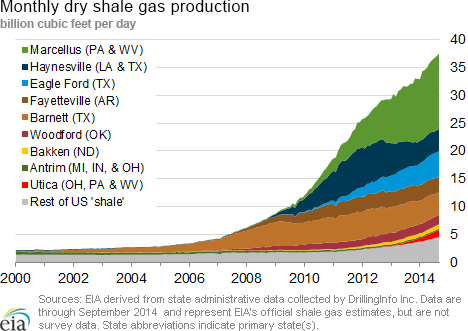In the News:
Demand ramps up with unseasonably cold weather
Unseasonably cold temperatures this week led to big increases in heating demand for natural gas from the residential and commercial sectors. Weather forecasters expect the cold to continue into next week, which will likely result in more natural gas consumption.
Bentek Energy estimated residential and commercial consumption yesterday hit 36.3 billion cubic feet (Bcf), the highest level since March, and then an estimated 42.1 Bcf today. An early winter storm blew through much of the central part of the United States, bringing cold temperatures and snow. The Rocky Mountain region was hit particularly hard by the wave of arctic air; in Denver, the high temperature of 16° F on Tuesday set a record for being the coldest daily high for that date. On Wednesday, Denver saw snow and a high temperature of 8°. In the Upper Midwest, areas of Wisconsin and Michigan received more than 20 inches of snow, while Minnesota and Montana received more than a foot of snow.
While the storm has mostly passed and moved on to Ontario, the National Weather Service said the Great Lakes states could expect some additional snowfall, and cold temperatures are expected to remain. Bentek projected residential and commercial consumption to remain at its current level or higher through the next seven days.
The East North Central Census Division (Wisconsin, Michigan, Illinois, Indiana, and Ohio) is the largest natural gas consuming division in the country, making up 28% of all residential consumption and 23% of commercial consumption in 2013. Because the East North Central has the largest number of households that use gas heat, its natural gas consumption response to changes in the temperature is the greatest among all regions in the country.
Elsewhere in the United States, winter conditions are expected in the coming days, according to the National Weather Service. A section of eastern Oregon and southern Idaho were under winter storm warnings yesterday and today. In the South, freeze warnings were issued for areas of Texas, Louisiana, and Alabama. On the East Coast, temperatures remained mild on Wednesday before dropping on Thursday.
Overview:
(For the Week Ending Wednesday, November 12, 2014)
- Spot prices rose at market locations across the country during the report week (Wednesday to Wednesday), with significantly colder-than-normal temperatures in many locations. The Henry Hub spot price rose from $3.80 per million British thermal units (MMBtu) last Wednesday, November 5, to $4.20/MMBtu yesterday, November 12.
- At the New York Mercantile Exchange (Nymex), the December 2014 contract fell slightly over the week, beginning at $4.194/MMBtu last Wednesday and ending at $4.185/MMBtu yesterday.
- Working natural gas in storage rose to 3,611 Bcf as of Friday, November 7, according to the U.S. Energy Information Administration (EIA) Weekly Natural Gas Storage Report (WNGSR). A net increase in storage of 40 Bcf for the week resulted in storage levels 5.7% below year-ago levels and 6.2% below the five-year average for this week.
- The total U.S. rotary rig count for the week ending November 7 fell by 4 units to 1,925 rigs, according to data from Baker Hughes Inc. The natural gas rig count increased by 10 units to 356, while oil rigs fell by 14 units to 1,568. The natural gas rig count has now risen for four consecutive weeks, adding a total of 36 rigs since October 10. The oil rig count in the Permian Basin grew by five in the week, but that growth was more than offset by a decrease of nine rigs in the Eagle Ford Basin, as well as decreases in other areas.
- The Mont Belvieu natural gas plant liquids composite price fell by 1.7% to $8.30/MMBtu for the week of November 3-7. With the exception of ethane, which increased by 8.6%, all of the other component prices fell. The price of natural gasoline, propane, isobutane, and butane declined by 4.4%, 3.0%, 2.4%, and 1.7%, respectively.
Prices/Demand/Supply:
Gas prices rise at all market locations with arctic blast. Natural gas prices rose at all market locations this week, as temperatures plunged in the Rockies and Midwest, and cold weather was anticipated by the end of the report week in other regions. After starting the report week last Wednesday at around $3.56/MMBtu, natural gas spot prices at trading locations in the Rockies climbed to more than $4.20/MMBtu at the close of Monday and maintained that level through the end of the report week. A similar price increase occurred at trading locations in the Midwest. Natural gas prices at the Chicago Citygate started the week at $4.03/MMBtu and increased to $4.41/MMBtu by Monday. Prices continued to climb at the Chicago Citygate on Tuesday, as temperatures plunged 25° F, and were around 40° F below average in some areas. Prices ended the report week at that location at $4.48/MMBtu.
As cold weather spread into the Northeast, prices increased. The Algonquin Citygate, which serves Boston, began the week at $4.06/MMBtu and rose to $6.15/MMBtu on Friday on forecasts of the coming cold weather. By Monday, prices fell to $4.97/MMBtu, before increasing to $8.04/MMBtu at the end of the report week with the arrival of colder-than-normal weather. Although prices at Transcontinental Pipeline's Zone 6 trading point for delivery to New York City also rose this week, the increase was more modest than Algonquin. Prices at Zone 6 started the report week at $3.28/MMBtu last Wednesday and rose to $3.99/MMBtu yesterday.
The Henry Hub spot price rose 40 cents from $3.80/MMBtu last Wednesday to $4.20/MMBtu yesterday.
Marcellus-area prices increase, but remain relatively low. The largest increase in the Marcellus area occurred at Dominion's South trading point in southwest Pennsylvania, where prices rose from $3.19/MMBtu last Wednesday to $3.62/MMBtu yesterday, an increase of 43 cents/MMBtu. Prices on Tennessee's Zone 4 Marcellus location and Transcontinental's Leidy Line increased 39 cents/MMBtu and 26 cents/MMBtu, respectively. Prices at Tennessee's Zone 4 Marcellus closed the week at $3.15/MMBtu, while prices at Transcontinental's Leidy Line ended the week at $3.35/MMBtu.
December futures contract price falls over the report week. After increasing in nine consecutive days of trading, from October 28 through November 7, the December futures contract fell during trading in the last three days of the report week. The December contract started the report week at $4.194/MMBtu, and peaked on Friday, November 7, at $4.412/MMBtu. Prices fell 23 cents/MMBtu in trading over Monday through Wednesday, and closed at $4.185/MMBtu yesterday, a slight decrease of less than a penny from Wednesday to Wednesday. The 12-month strip, the average of December 2014 through November 2015, also ended the week down by a penny, ending the report week at $3.938/MMBtu.
Consumption outstrips supply for the first time since mid-April. Dry production remained relatively flat this week. After surpassing a record 71 billion cubic feet/day (Bcf/d) on Monday, production fell below 70 Bcf/d for the remainder of the report week, according to Bentek Energy data. Imports of natural gas from Canada increased slightly, driven by increased imports into the West and Midwest regions, while LNG sendout remained minimal.
Total demand increased to its highest levels since March, propelled by growth in residential and commercial consumption. Residential and commercial consumption increased by more than 30% from Tuesday to Wednesday, as cold weather spread throughout the country. This represents a one-day, eight-Bcf increase, and brought residential and commercial consumption to its highest level since March 26. Over the entire report week, residential and commercial consumption increased by 11.2% from last week, supporting a 4.2% growth in overall demand. Industrial consumption rose 2.7%, and consumption of natural gas for electric power generation dropped 3.3%.
Storage
Weekly Natural Gas Storage Report (WNGSR) has been published to reflect the latest storage inventory data with the release this morning on Friday, November 14, 2014.
Net injections slow with colder temperatures. The net injection reported for the week ending November 7 was 40 Bcf. Despite being 51 Bcf lower than the net injection last week, this week’s net injections exceeded the five-year average net injection by 24 Bcf and last year’s net injection by 18 Bcf. Working gas inventories as of November 7 totaled 3,611 Bcf, 220 Bcf (5.7%) less than last year at this time and 237 Bcf (6.2%) below the five-year (2009-13) average.
Storage build is slightly larger than expectations. Market expectations called for an average build of 38 Bcf. When the EIA storage report was released at 10:30 a.m., the price for the December natural gas futures contract fell four cents to $3.99/MMBtu in trading on the Nymex.
Since the start of April, the United States has added a record 2,785 Bcf of natural gas to storage. This is significantly higher than the net storage injection of 2,156 over the same period last year, and 2,025 Bcf for these weeks between 2009 and 2013, on average. The average unit value of what storage holders put into storage from April 4 to November 7 was $4.20/MMBtu, 12% higher than the average value for the same 31 weeks last year of $3.76/MMBtu. The highest winter-month Nymex price (for the January 2015 contract) in trading for the week ending on November 7 averaged $4.22/MMBtu. This is 9 cents more than the current front month Nymex contract price for that week. A year ago, the difference was 47 cents/MMBtu.
All regions post larger-than-average builds. The East, West, and Producing regions had net injections of 8 Bcf (5 Bcf larger than its five-year average), 4 Bcf (1 Bcf larger than its five-year average), and 28 Bcf (18 Bcf larger than its five-year average), respectively. Storage levels for all three regions remain below their year-ago and five-year average levels.
Temperatures during the storage report week were less than a degree cooler than the 30-year average. Temperatures in the Lower 48 states averaged 49.7° for the week, 0.6° cooler than the 30-year normal temperature and 2.4° cooler than during the same period last year. There were also 110 population-weighted heating degree days during the storage report week, 2 more than the 30-year normal and 14 more than the same period last year.
See also:
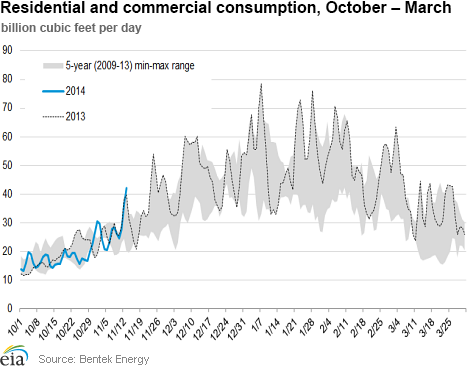
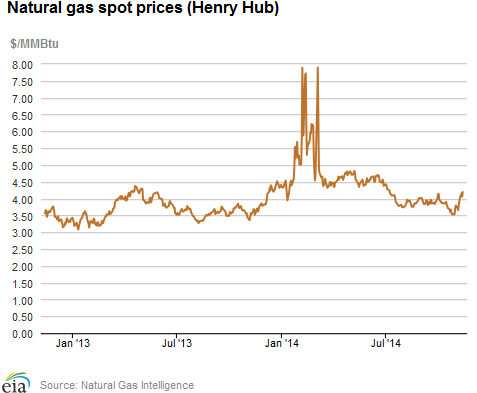
| Spot Prices ($/MMBtu) | Thu, 06-Nov |
Fri, 07-Nov |
Mon, 10-Nov |
Tue, 11-Nov |
Wed, 12-Nov |
|---|---|---|---|---|---|
| Henry Hub |
3.91 |
4.01 |
4.16 |
4.06 |
4.20 |
| New York |
3.74 |
3.40 |
3.56 |
3.74 |
3.99 |
| Chicago |
4.11 |
4.07 |
4.41 |
4.54 |
4.48 |
| Cal. Comp. Avg,* |
4.07 |
4.07 |
4.46 |
4.36 |
4.36 |
| Futures ($/MMBtu) | |||||
| December Contract |
4.404 |
4.412 |
4.255 |
4.247 |
4.185 |
| January Contract |
4.486 |
4.507 |
4.351 |
4.344 |
4.284 |
| *Avg. of NGI's reported prices for: Malin, PG&E citygate, and Southern California Border Avg. | |||||
| Source: NGI's Daily Gas Price Index | |||||
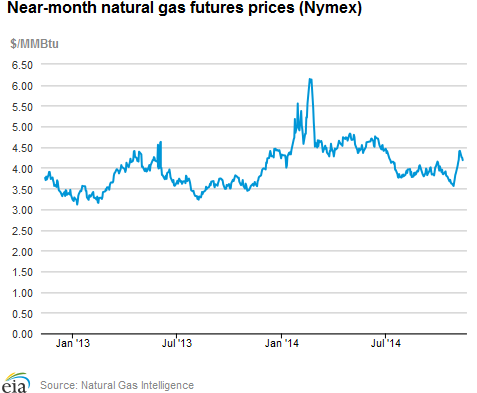
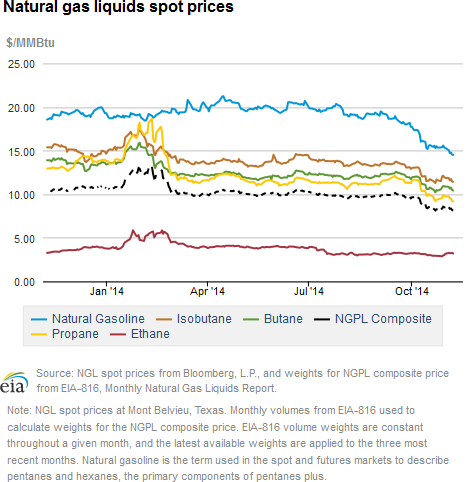
| U.S. Natural Gas Supply - Gas Week: (11/5/14 - 11/12/14) | ||
|---|---|---|
Percent change for week compared with: |
||
last year |
last week |
|
| Gross Production | 5.32%
|
-0.58%
|
| Dry Production | 5.28%
|
-0.57%
|
| Canadian Imports | 9.77%
|
5.55%
|
| West (Net) | 29.20%
|
5.81%
|
| MidWest (Net) | 6.61%
|
1.22%
|
| Northeast (Net) | -55.16%
|
64.59%
|
| LNG Imports | -76.47%
|
0.92%
|
| Total Supply | 5.37%
|
-0.14%
|
| Source: BENTEK Energy LLC | ||
| U.S. Consumption - Gas Week: (11/5/14 - 11/12/14) | ||
|---|---|---|
Percent change for week compared with: |
||
last year |
last week |
|
| U.S. Consumption | -2.3%
|
4.2%
|
| Power | -6.4%
|
-3.3%
|
| Industrial | 0.7%
|
2.7%
|
| Residential/Commercial | -1.6%
|
11.2%
|
| Total Demand | -2.0%
|
4.2%
|
| Source: BENTEK Energy LLC | ||
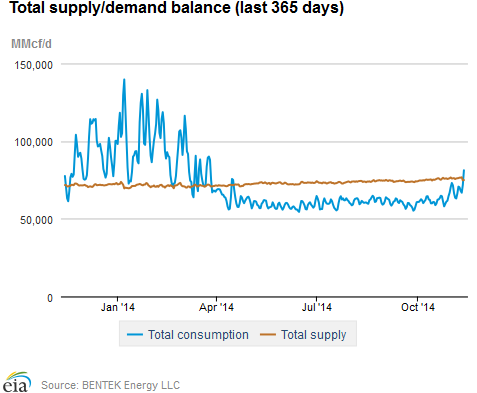
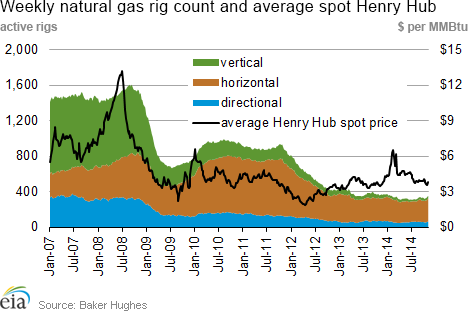
| Rigs | |||
|---|---|---|---|
Fri, November 07, 2014 |
Change from |
||
last week |
last year |
||
| Oil Rigs | 1,568 |
-0.88% |
13.38% |
| Natural Gas Rigs | 356 |
2.89% |
-2.47% |
| Miscellaneous | 1 |
0.00% |
-83.33% |
| Rig Numbers by Type | |||
|---|---|---|---|
Fri, November 07, 2014 |
Change from |
||
last week |
last year |
||
| Vertical | 360 |
-1.37% |
-13.67% |
| Horizontal | 1,362 |
0.67% |
22.26% |
| Directional | 203 |
-3.79% |
-8.97% |
| Source: Baker Hughes Inc. | |||
| Working Gas in Underground Storage | ||||
|---|---|---|---|---|
Stocks billion cubic feet (bcf) |
||||
| Region | 2014-11-07 |
2014-10-31 |
change |
|
| East | 1,964 |
1,956 |
8 |
|
| West | 502 |
498 |
4 |
|
| Producing | 1,145 |
1,117 |
28 |
|
| Total | 3,611 |
3,571 |
40 |
|
| Source: U.S. Energy Information Administration | ||||
| Working Gas in Underground Storage | |||||
|---|---|---|---|---|---|
Historical Comparisons |
|||||
Year ago (11/7/13) |
5-year average (2009-2013) |
||||
| Region | Stocks (Bcf) |
% change |
Stocks (Bcf) |
% change |
|
| East | 1,983 |
-1.0 |
2,066 |
-4.9 |
|
| West | 553 |
-9.2 |
531 |
-5.5 |
|
| Producing | 1,295 |
-11.6 |
1,251 |
-8.5 |
|
| Total | 3,831 |
-5.7 |
3,848 |
-6.2 |
|
| Source: U.S. Energy Information Administration | |||||
| Temperature -- Heating & Cooling Degree Days (week ending Nov 06) | ||||||||
|---|---|---|---|---|---|---|---|---|
HDD deviation from: |
CDD deviation from: |
|||||||
| Region | HDD Current |
normal |
last year |
CDD Current |
normal |
last year |
||
| New England | 141
|
4
|
7
|
0
|
0
|
0
|
||
| Middle Atlantic | 128
|
0
|
13
|
0
|
0
|
0
|
||
| E N Central | 149
|
7
|
30
|
0
|
0
|
0
|
||
| W N Central | 150
|
-3
|
10
|
0
|
0
|
0
|
||
| South Atlantic | 100
|
20
|
34
|
8
|
-8
|
-12
|
||
| E S Central | 112
|
31
|
49
|
0
|
-2
|
-2
|
||
| W S Central | 53
|
6
|
15
|
10
|
-3
|
-7
|
||
| Mountain | 109
|
-30
|
-34
|
5
|
2
|
3
|
||
| Pacific | 55
|
-8
|
-6
|
1
|
-1
|
1
|
||
| United States | 110
|
2
|
14
|
3
|
-2
|
-3
|
||
|
Note: HDD = heating degree-day; CDD = cooling degree-day Source: National Oceanic and Atmospheric Administration | ||||||||
Average temperature (°F)
7-Day Mean ending Nov 06, 2014
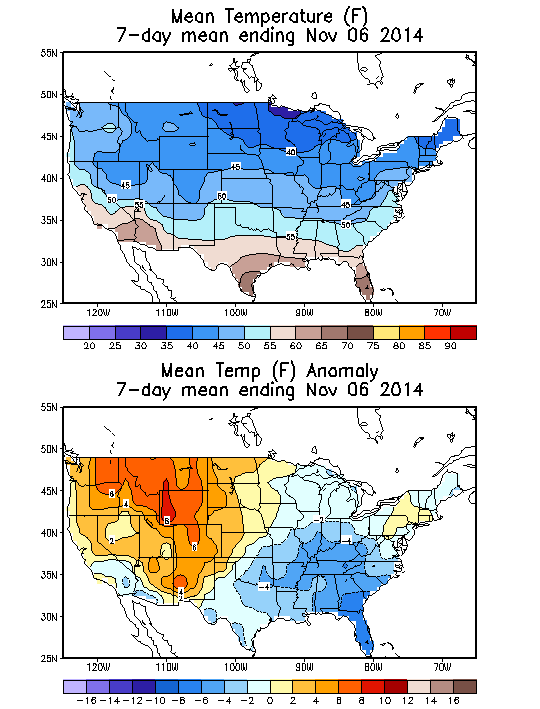
Source: NOAA/National Weather Service
Deviation between average and normal (°F)
7-Day Mean ending Nov 06, 2014

Source: NOAA/National Weather Service

